Criminal Justice Social Work Statistics 2011-12
This statistical bulletin presents national level information on activity relating to community penalties in Scotland, including Criminal Justice Social Work Reports and “social work orders” - made up of Community Payback Orders (CPOs), the predecessors to CPOs (Community Service Orders, Probation Orders and Supervised Attendance Orders) and Drug Treatment & Testing Orders.
This document is part of a collection
4 Social work orders
(Tables 1, 2 & 5 to 23, Charts 3 to 5)
4.1 In this bulletin, the term "social work orders" includes Community Payback, Community Service, Probation, Supervised Attendance and Drug Treatment & Testing orders. Community Payback Orders (CPOs) replaced Community Service, Probation and Supervised Attendance orders for offences committed on or after 1 February 2011.
4.2 The total number of social work orders commenced in 2011-12 was 19,700 (Tables 1 & 2). This represented an increase on 2010-11 and took total orders back to around the same level as the 19,900 in 2009-10. This reflects patterns in sentencing (see Criminal Proceedings in Scotland publication for details).
4.3 Local authority and community justice authority level breakdowns of the figures in this bulletin are available for each of the different social work order types in the extra datasets at CJA/LA level which accompany the publication.
4.4 CPOs consisted of 10,200 (just over half) of all social work orders commenced in 2011-12 (Table 1). In the future, as fewer social work orders will relate to crimes committed before 1 February 2011, CPOs will form an increasingly high proportion of total orders.
4.5 Eighty-four per cent of total social work orders in 2011-12 (16,700) were for males (Table 2). Recipients of an SAO were the most likely to be male (88 per cent) while recipients of a PO were the least likely (79 per cent).
4.6 Those aged 31 to 40 accounted for the largest number of orders (4,700 - 24 per cent) in 2011-12 (Table 2), However, the largest group as a proportion of the population was for those aged 18 to 20, with 140 orders per 10,000 population (Chart 3). This proportion was also high for people aged 21 to 25 (120 per 10,000 population).
4.7 For each of CPOs, CSOs and POs, numbers were highest as a proportion of the population for 18 to 20 year olds (77, 23 and 27 per 10,000 population, respectively). SAOs were most commonly given to 21 to 25 year olds, while for DTTOs, it was those aged between 26 and 40.
Chart 3 Number of social work orders per 10,000 population by age group, 2011-12
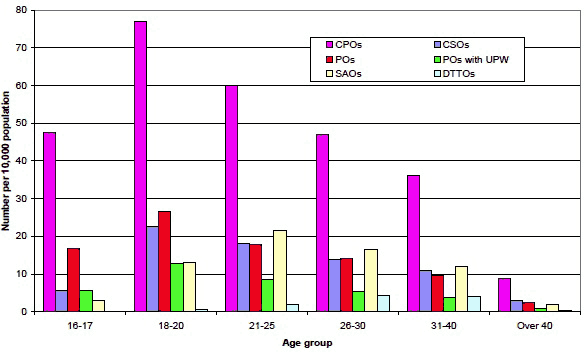
Notes relating to social work orders in Chart 3:
Rates are based on mid-year population estimates, with the rate for "Over 40" based on those aged 41 to 70. The 16-17 year old category includes a small number of orders relating to clients aged under 16 years.
4.8 The employment status of offenders provides an indication of whether the offender is likely to be available for work during normal working hours (i.e. weekdays between 9am and 5pm). Most social work orders related to people who were unemployed (61 per cent), with 20 per cent employed or self-employed and 11 per cent not seeking employment (Table 2 & Chart 4).
4.9 CSOs had by far the highest proportion employed/self-employed (35 per cent), with the next highest for POs with unpaid work (22 per cent) and the lowest for DTTOs (just 4 per cent). Only half of people who commenced a CSO in 2011-12 were unemployed, whereas this was the case for nearly 4 out of 5 of those who started a DTTO.
4.10 Where information on ethnicity was known and was provided, 97 per cent of social work orders commenced in 2011-12 related to offenders who were white (Table 2). This proportion did not vary greatly by order type.
Chart 4 Orders commenced by employment status : different order types, 2011-12
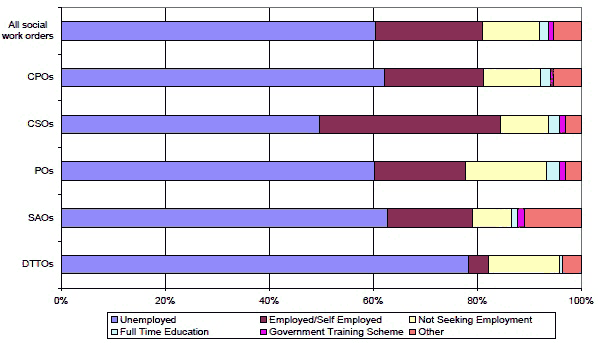
Note relating to Chart 4 : "Other" includes employment status not known, retired, part time education, custody, supported by parents, caring for relatives, permanently sick, not eligible for benefits.
4.11 There were 7,800 CPOs commenced in 2011-12 which had an unpaid work or other activity requirement (Tables 8 & 9). As a result, around 15,000 orders (i.e. CSOs, SAOs and both CPOs and POs with unpaid work) consisted of an element of unpaid work or other activity in 2011-12. This was 76 per cent of all social work orders - a noticeable increase from around 68 per cent in 2010-11.
4.12 Total breach applications of social work orders in 2011-12 was 6,900, a fall of 13 per cent on 2010-11 and the lowest total since 2005-06 (Table 1).
4.13 The number of terminations of social work orders in 2011-12 was 17,200, 4 per cent lower than in 2010-11 and the lowest annual total since 2007-08. Thirty-eight per cent of terminations were for POs while a further 27 per cent were for CSOs. CPOs and SAOs each accounted for 15 per cent of all terminations (Table 1).
4.14 There were 11,800 successful completions of social work orders in 2011-12, 69 per cent of all terminations (Table 1 & Chart 5). This was the highest proportion in the period since data was first collected for all four order types in 2003-04, and has shown a consistent upward trend in recent years, from 59 per cent in 2008-09 and 64 per cent in 2010-11. The successful completion rate was highest in 2011-12 for CSOs (74 per cent) and lowest for DTTOs (54 per cent).
Chart 5 Proportion of terminations which were successful completions, 2007-08 to 2011-12
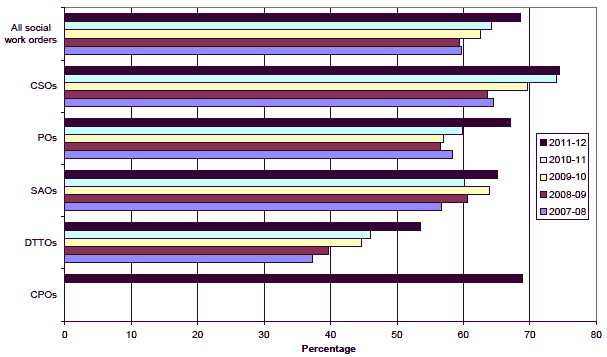
I. Community Payback Orders (CPOs)
(Tables 1, 2 & 5 to 13, Charts 3 to 7)
4.15 The CPO was introduced from 1 February 2011, to replace CSOs, POs and SAOs for offences committed on or after that date.
4.16 In order to reduce the burden on data suppliers, figures for the number of CPOs were not collected from local authorities for 2010-11. The numbers imposed in that year were expected to be very low and information obtained from the Scottish Court Service (SCS) on CPO numbers, in the early months since their introduction, indicated that around 330 CPOs were imposed during February and March 2011. Monthly figures obtained from SCS, covering the period February 2011 to March 2012, are published on the Scottish Government website as part of the criminal justice social work datasets page.
4.17 Data collected from local authorities for 2011-12 showed that a total of 10,200 CPOs commenced in that year (Tables 1 & 2). Eighty-six per cent (8,800) of CPOs commenced in 2011-12 were for males (Table 2) while people aged 18 to 20 were the most likely to be given a CPO (Chart 3).
4.18 In 62 per cent of CPOs in 2011-12, the offender was unemployed - around the same as for social work orders as a whole (Table 2 & Chart 4). A further 19 per cent were employed or self-employed and 11 per cent were not seeking employment.
4.19 A CPO can consist of one of more of the following requirements:
a. Offender supervision
b. Compensation
c. Unpaid work or other activity
d. Programme
e. Residence
f. Mental health treatment
g. Drug treatment
h. Alcohol treatment
i. Conduct
In addition, if an offender has failed to comply with one or more of the requirements in the order, a further requirement can be imposed after the original imposition of the order, namely a restricted movement requirement.
Chart 6 Number of CPO requirements at first disposal issued, 2011-12
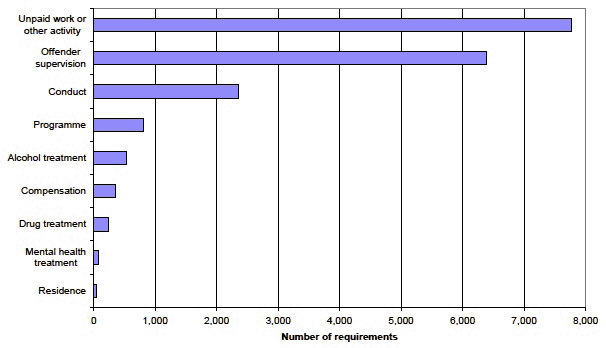
4.20 The most commonly issued requirements in 2011-12 were unpaid work or other activity (7,800) and offender supervision (6,400) (Table 6 & Chart 6). These accounted for, respectively, 76 and 62 per cent of all orders issued. The most common other requirements issued were conduct (2,400), programme (810) and alcohol treatment (540). Amongst requirements which can be issued at first imposition of the order, those which were the least commonly issued were residence (51) and mental health treatment (74).
4.21 The Scottish Government published Community Payback Orders Practice Guidance to help support practitioners and managers to improve their performance and results towards the achievement of National Outcomes and Standards for Social Work Services in the Criminal Justice System. The guidance contains a number of principles of best practice, including:
a. The first direct contact with the offender should take place on the same day as the CPO is imposed or, if this is not possible, the next working day.
b. Where a CPO containing an offender supervision requirement has been imposed, the appointed case manager should arrange to meet the individual within 5 working days of the date of imposition of the order.
c. Where a CPO containing an unpaid work or other activity requirement has been imposed, arrangements should be made for the individual to begin the induction process within 5 working days of the date of imposition of the order.
d. Where a CPO containing an unpaid work or other activity requirement is imposed, the work placement should begin within 7 working days of the imposition of the CPO.
Local authorities were asked to provide this information for 2011-12 for all orders, with the exception of those which were transferred in from other local authority areas / countries and also those where offenders did not (or were unable to) comply with the order.
4.22 For CPOs commencing in 2011-12, first direct contact took place on the same working day as the order was imposed in 68 per cent of cases (Table 7). In a further 9 per cent of cases, first direct contact took place the following working day. For 10 per cent of cases, it took longer than five working days to establish this contact.
4.23 The first induction / case management meeting took place within five working days in 83 per cent of cases (Table 7). A further 9 per cent took between six and ten working days, with the remaining 8 per cent taking longer than ten working days.
4.24 For CPOs which commenced and had an unpaid work or other activity requirement at the time of imposition, 71 per cent commenced their work placement within seven working days (Table 9). The majority of the remainder (17 per cent) began their work placement within three weeks, with only 4 per cent taking longer than two months to start work.
4.25 There are a range of reasons for not achieving full compliance for these principles of best practice. Some of these reasons can be service-based, for example if suitable work is not available or suitable social work staff are not available. However, there are also client-based reasons involved, for example if the offender is ill or simply does not turn up. It is intended to collect information in 2012-13 on the reasons behind non-compliance as part of the unit level return (see §4.36).
4.26 Almost 7,800 CPOs were commenced in 2011-12 which had an unpaid work or other activity requirement as part of the order when first imposed (Table 8). An unpaid work or other activity requirement can be imposed with a minimum of 20 hours and a maximum of 300 hours. Such requirements can be subdivided into level 1 requirements - those with 100 or less hours - and level 2 requirements - those with more than 100 hours.
4.27 CPOs commenced in 2011-12 with unpaid work were more or less equally likely to have a level 1 requirement (51 per cent) as a level 2 (49 per cent). The average number of hours imposed for these requirements was 78 hours for level 1, 164 hours for level 2 and 120 hours across all unpaid work or other activity requirements.
4.28 There were 6,400 CPOs commenced in 2011-12 which contained an offender supervision requirement (Table 10). The most common lengths for these requirements were 12 months (2,900 - 46 per cent) and 18 months (1,200 - 19 per cent). Only a small proportion (3 per cent) had lengths of more than two years. The average length of an offender supervision requirement was just over 14½ months.
Breach applications for CPOs
4.29 There were 1,400 breach applications made to the courts in 2011-12 in respect of CPOs (Table 11). This represented 20 per cent of all breach applications of social work orders in 2011-12 (Table 1).
4.30 The number of breach applications is not directly related to the number of orders commenced (provided in §4.17) as they may relate to orders commenced in previous years, and some orders may be subject to more than one breach application.
4.31 Around 17 per cent of breach applications resulted in the original order being revoked and a custodial sentence imposed. A further 20 per cent of breaches resulted in the original order being revoked and some other action taken (including probation and a new CPO issued). In 18 per cent of applications, the original order was continued and no further action taken by the court. In a further 5 per cent of applications, a warrant for apprehension/recall was made. Information on outcome was not available for just under a quarter of all breach applications made in 2011-12, in part due to lags in recording outcomes.
Terminations of CPOs and unpaid work or other activity requirements
4.32 A total of 2,600 CPOs were terminated in 2011-12 (Table 12). Approximately 69 per cent (1,800) of these orders were either successfully completed or resulted in an early discharge.
4.33 A further 17 per cent were revoked following a breach application to the courts, 4 per cent were revoked following a review and the remaining 11 per cent were terminated for other reasons (including transfer to another area or death of the offender).
4.34 In 2011-12, just over 2,500 unpaid work or other activity requirements were successfully completed (Table 13). Although roughly equal numbers of level 1 and level 2 requirements were imposed during 2011-12 (Table 8), the majority of unpaid work requirements completed in 2011-12 were level 1 (1,610 - 64 per cent) (Table 13). This is unsurprising as, with the first CPOs being imposed only two months before the start of 2011-12, the shorter length unpaid work requirements are more likely to have been completed by the end of this year.
4.35 Completed requirements contained an average of 99 hours (68 hours for level 1 and 152 hours for level 2) and took on average 120 calendar days to complete (102 days for level 1 and 150 days for level 2) (Table 13).
Future collection of data for CPOs
4.36 It is intended to collect data on CPOs from local authorities at a unit rather than aggregate level from 2012-13. This will greatly increase the amount of information on the implementation process. The main benefits of the unit level data will be the ability to report on the process and outcome of individual orders, such as breach rates. This is not possible with the current aggregate return, as figures on outcomes are recorded separately from information on commencements and breach applications
Chart 7 CPOs by number of requirements in orders, 2011-12
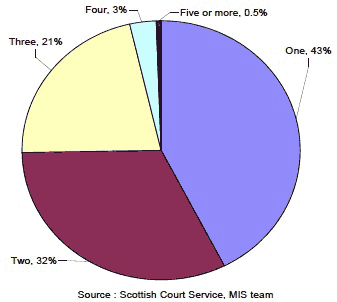
4.37 The monthly CPO data provided by Scottish Court Service (SCS) contains some information which local authorities were not asked to provide in 2011-12 but which it will be possible for them to produce in 2012-13. Some of the most useful findings from the SCS data for 2011-12 were:
- Almost 95 per cent of CPOs were imposed in sheriff courts.
- Eighteen per cent of CPOs were imposed with a provision to conduct progress reviews.
- Forty-three per cent of orders consisted of only one requirement (either an unpaid work or other activity or an offender supervision requirement). Only 4 per cent contained four or more requirements (Chart 7).
4.38 The monthly SCS data is not directly comparable with the CPO data supplied by local authorities, as they are not compiled on exactly the same basis. For example:
- Where two or more identical and fully concurrent orders are issued, the SCS data counts each of these individually while, in the data supplied by local authorities, the authorities are asked to count only one order.
- The SCS data may include some orders given to non-residents of Scotland which will not be included in the local authorities' data.
II. Community Service Orders (CSOs)
(Tables 1, 2, 5 & 14 to 15, Charts 3 & 5)
4.39 A total of 3,000 CSOs (excluding Probation Orders with a requirement of unpaid work) were made in 2011-12 (Table 1). This was a sharp decrease on the 2010-11 total of 5,900 and was entirely expected due to the introduction of the CPO.
4.40 The average length of CSOs commenced in 2011-12 was 156 hours, an increase of around 6 hours from 2010-11, and around 11 hours greater than the average in 2007-08 of 145 (Table 5).
Breach Applications of CSOs
4.41 There were 1,300 breach applications made to the courts in 2011-12 in respect of CSOs. As expected, this represented a substantial decrease compared with the 1,900 breach applications in 2010-11 (Tables 1 & 14).
4.42 Around 14 per cent of breach applications resulted in the original order being revoked and a custodial sentence imposed, which was similar to 2010-11 (Table 14). A further 19 per cent of breaches in 2011-12 resulted in the original order being revoked and some other action taken (including probation and monetary penalty). In 17 per cent of applications, the original order was continued and no further action taken by the court. In a further 6 per cent of applications, a warrant for apprehension/recall was made. The outcome was not yet known for 18 per cent of breach applications made in 2011-12, partly due to time lags in reporting.
Terminations of Community Service Orders
4.43 A total of 4,700 CSOs were terminated in 2011-12, an expected decrease from 2010-11 (Table 1). Approximately 74 per cent (3,500) of these orders were successfully completed (Table 15), around the same proportion as in 2010-11. The successful completion rate for CSOs was higher than for any of the other social work orders (Chart 5).
4.44 In 2011-12, a further 15 per cent of terminations involved revocation following a breach application to the courts, 4 per cent involved revocation following a review, and the remaining 6 per cent were terminated for other reasons (including transfer to another area or death of the offender) (Table 15).
III. Probation Orders (POs)
(Tables 1, 2, 5 & 16 to 18, Charts 3 & 5)
4.45 A total of 3,000 POs (including POs with a requirement of unpaid work) were made in 2011-12 (Table 1). This showed a sharp fall in the numbers since the previous year, which was expected as a result of the introduction of the CPO.
4.46 The average length of a PO in 2011-12 was 17.3 months, higher than in each of the previous four years, where the average had hovered around the 16½ month mark (Table 5).
4.47 Around 34 per cent of all POs had standard conditions only (Table 16). A requirement of unpaid work was made in a further 34 per cent of orders - this was noticeably higher than in the previous four years, when it has remained steady around the 30 per cent mark, reflecting a greater emphasis on unpaid work in 2011-12. Thirteen per cent included conditions of alcohol or drug treatment/education.
Breach Applications of POs
4.48 There were 2,700 breach applications made to the courts in 2011-12 in respect of POs. As expected, this represented a substantial fall compared with the 4,100 applications in 2010-11 (Tables 1 & 17).
4.49 The number of breach applications is not directly comparable with the number of orders provided in §4.45 (which covers new orders only) as some of the breach applications may relate to orders started in previous years.
4.50 Around 17 per cent of breach applications resulted in the original order being revoked and a custodial sentence imposed, 9 per cent resulted in revocation and a new probation order, 2 per cent in revocation and a community service order and 9 per cent in revocation and some other action taken (including a monetary penalty). In 21 per cent of applications, the original order was continued and no further action taken by the court. The outcome was not yet known in 24 per cent of applications, in part due to time lags in reporting outcomes.
Terminations of POs
4.51 A total of 6,600 POs were terminated in 2011-12, an expected decrease from the 2010-11 total (Table 1). Sixty-seven per cent of these orders (4,400) were successfully completed (including early discharge following a review) in 2011-12 (Table 18). This was a substantial rise compared with the previous year's figure of 60 per cent, and was 9 percentage points higher than in 2007-08.
4.52 In 2011-12, the successful completion rate for POs was lower than the rate for CSOs and CPOs but higher than for SAOs or DTTOs (Chart 5).
4.53 Nineteen per cent of the total in 2011-12 were terminated following a breach application while the remaining 14 per cent were terminated for other reasons (including transfer to another area or death of the offender).
IV. Probation Orders (POs) with a Requirement of Unpaid Work
(Tables 1, 2, 5 & 19, Chart 3)
4.54 A total of 1,300 POs with a requirement of unpaid work were made in 2011-12 (Table 1). This represented a decrease from the 2010-11 total of 3,000 orders, a fall which was expected due to the introduction of the CPO.
4.55 The average length of a PO with a Requirement of Unpaid Work showed a small but steady increase between 2007-08 and 2010-11, from 135 to 139 hours. This then rose sharply to 151 hours in 2011-12 (Table 5).
Breach Applications of POs with a Requirement of Unpaid Work
4.56 There were around 1,100 breach applications made to the courts in 2011-12 in respect of POs with a Requirement of Unpaid Work, a decrease compared to the 2010-11 total of 1,700 applications (Tables 1 & 19).
4.57 Sixteen per cent of all breach applications in 2011-12 resulted in the original order being revoked and custody being imposed, while 9 per cent resulted in revocation and a new probation order (Table 19). In 2 per cent of applications, the order was revoked and a community service order imposed. Ten per cent resulted in revocation with some other action taken (including a monetary penalty) and, in 20 per cent of applications, the original order was continued with no further action taken by the court. The outcome was not yet known in 23 per cent of applications.
V. Supervised Attendance Orders (SAOs)
(Tables 1, 2, 5 & 20 to 21, Charts 3 & 5)
4.58 A total of 2,900 SAOs were imposed in 2011-12, a decrease of about 400 compared to 2010-11 (Table 1) and the lowest since 2006-07. This fall was expected, due to the introduction of the CPO, but the fall in SAO numbers has been substantially less dramatic than the fall observed for CSOs and POs. This is likely to reflect the nature of SAOs, in that they are more likely to relate to an original offence committed some time before 1 February 2011.
4.59 The average length of an SAO in 2011-12 was 47 hours, the same as in 2010-11 but around 7½ hours more than in 2007-08 (Table 5).
Breach Applications of SAOs
4.60 There were 1,300 breach applications in respect of SAOs made to the courts in 2011-12, a decrease on 2010-11 as expected (Tables 1 & 20).
4.61 In 2011-12, 11 per cent of breach applications resulted in the original order being revoked and a custodial sentence being imposed. A further 28 per cent were continued without further action, and 11 per cent were continued with hours varied. The outcome was not yet known for 18 per cent of breach applications, down from 29 per cent in 2008-09 (Table 20).
Terminations of SAOs
4.62 A total of 2,600 SAOs were terminated in 2011-12 (Table 1). Sixty-five per cent were successfully completed in 2011-12, the highest in any of the last seven years and a noticeable improvement on the level of 60 per cent in 2010-11.
4.63 The successful completion rate for SAOs in 2011-12 was slightly lower than the rate for CPOs and POs but higher than for DTTOs (Chart 5).
4.64 In 2011-12, 21 per cent of terminations were revoked due to a breach (Table 21). A further 7 per cent were revoked following a review and the remaining 6 per cent were terminated for other reasons (including transfer to another area and death of the offender).
VI. Drug Treatment and Testing Orders (DTTOs)
(Tables 1, 2, 5 & 22 to 23, Charts 3, 5 & 8)
4.65 The DTTO is available as a disposal to the High Court and all sheriff courts in Scotland. In 2011-12, just over 1,000 DTTO assessments were made, a decrease of 19 per cent from 2010-11 and continuing the downward trend witnessed since 2008-09, when 1,700 assessments were made (Chart 8). A total of 560 DTTOs were made in 2011-12, a decrease of 16 per cent on 2010-11 and the lowest in any of the last seven years (Table 1 and Chart 8).
Chart 8 DTTO assessments, commencements and terminations, 2005-06 to 2011-12
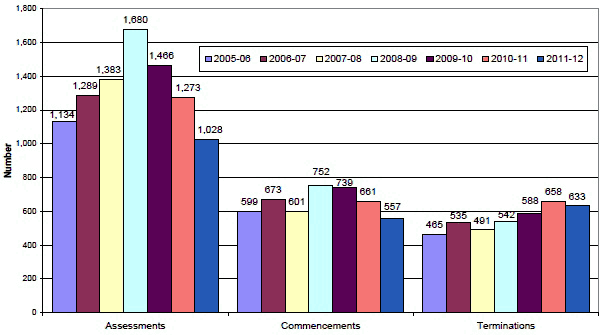
4.66 Male offenders accounted for 82 per cent of DTTOs commenced in 2011-12 (Table 2). The incidence of DTTOs was highest amongst 26 to 30 and 31 to 40 year olds (both 4 per 10,000 population) (Chart 3). Numbers were very low (less than ½ per 10,000 population) for those aged under 21.
4.67 A higher proportion of DTTOs related to unemployed offenders (78 per cent) than any other type of social work order (Table 2 & Chart 4). A further 14 per cent were not seeking employment with only 4 per cent either employed or self-employed.
4.68 The average length of a DTTO in 2011-12 was 17.6 months, around 25 days less than in 2010-11 and the lowest level in any of the last five years (Table 5).
Breach Applications of DTTOs
4.69 There were 190 breach applications made to courts in 2011-12 in respect of DTTOs, a decrease of 18 per cent from 230 in 2010-11 and the lowest in any of the last seven years (Table 22). The number of breach applications is not directly comparable with the number of orders commenced as some breach applications may relate to orders started in the previous year.
4.70 Around 25 per cent of breach applications resulted in the original order being revoked and a custodial sentence imposed, lower than the figure for 2010-11 of 29 per cent. In 2011-12, 2 per cent resulted in revocation and a new DTTO imposed whilst a further 24 per cent resulted in revocation and some other action taken. Eleven per cent of applications resulted in no further action taken by the court and a further fifth of outcomes were not yet known.
Terminations of DTTOs
4.71 After consistent increases since 2007-08, the number of DTTO terminations fell between 2010-11 and 2011-12, by 4 per cent to 630 (Table 23). Fifty-four per cent of terminations were successful completions in 2011-12, a notable increase from 46 per cent in 2010-11 and comfortably the highest proportion since data was first collected on DTTOs in 2003-04. The successful completion rate for DTTOs was nevertheless lower than for any of the other types of social work orders, mainly due to the type of offender receiving this particular order.
4.72 Twenty per cent were terminated following a breach application in 2011-12 (down from 28 per cent in 2010-11). Fourteen per cent were revoked due to review in 2011-12, with the remaining 12 per cent terminated for other reasons (including transfer out of the area or death).
Contact
Email: Howard Hooper
There is a problem
Thanks for your feedback